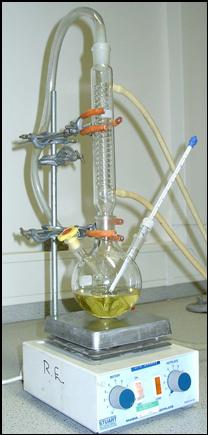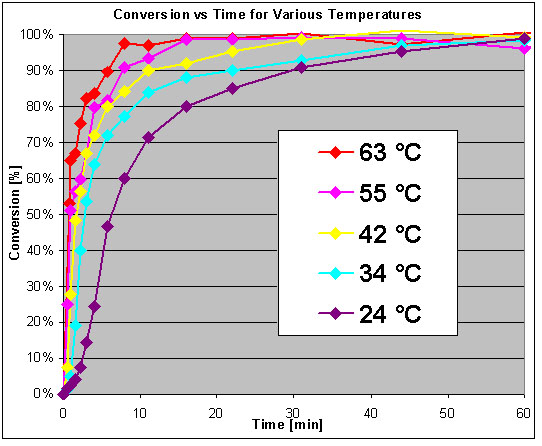lWeigh out about 0.510 g of sodium hydroxide pellets and finely grind with a mortar and pestle. Place this mixture in a 250 ml beaker, and add 2.01 g
of silicic acid and 1.01 g of tetrapropylammonium bromide. Mix with 5.0 ml distilled water, then add 1.0 ml of n-propylamine and mix the solution
again.
Place 1.0 ml of a prepared 1 molar solution of aluminum sulfate along with about 0.05 ml of the concentrated sulfuric acid in a separate 50 ml beaker.
Then add the first solution to this beaker as well. Add enough distilled water to raise the volume to about 25 ml, and mix the solution (26 ml total
volume) on a stir plate for ten minutes. Then transfer the solution to the Parr "Bomb" and seal it. Gently shake it, before placing in the oven. Heat
the sample to 160°C and hold there for 44 hours (note how long it takes to reach 160°C). Do not worry if you cannot remove every last trace of the
solid out of the beaker.
After 2 days heating, turn off the oven and remove the Parr reactor and let it cool to room temperature. Remove a small sample for x-ray analysis. If
the x-ray pattern matches the expected one, see figure 2, then filter the rest of the reactant in a Buchner funnel with fine filter paper (541 grade).
Wash it three times with copious amounts of water and then dry for 20 minutes on the filter paper.
You are now going to calcine the sample to remove the organic cation, so set-up the tube furnace assembly (Figure 2). Place the zeolite inside, on top
of the frit in the middle of the tube, and spread out to maximize the surface area. Fit a ground glass elbow at each end, one attached to a nitrogen
cylinder and the other immersed in a beaker of water, to regulate the flow of nitrogen gas. Slowly heat the tube to 500°C in increments of 50 to
100°C, when water vapor will be released, then in increments of 100 to 500°C. Heat for two hours after reaching temperature, where the
tetrapropylammonium bromide will decompose to tripropylamine, propylene, and water. Cool and weigh the materials (note the weight in g). Remove
another sample for x-ray analysis; how does it compare to the previous x-ray?.
Any sodium ions remaining in the zeolite will now be ion exchanged for protons to fully convert the zeolite to the acid form. The sodium product from
above is placed in a 100 ml beaker, and stirred with 12.60 ml of 1 M aqueous ammonium sulfate for 15 minutes. Collect the zeolite by Buchner
filtration (repeat for a total of 3 washings). Wash the product with small amounts of acetone. Then wash several times with distilled water to remove
all sulfate ions. Test the washings for this anion by adding drops of an aqueous solution of BaCl2; the formation of a BaSO4 precipitate indicates the
presence of the ion.
When the solution no longer produces a precipitate, wash the zeolite once more with acetone to dry it, and then dry in the oven at 120°C for 20
minutes. The acid hydrogen form of the compound is prepared by transferring the oven-dried compound to a tube furnace. Heat the ammonium zeolite for 3
hours to ensure the thermal decomposition of the NH4+ ions. Over the course of this process, the zeolite should turn from a white to brown/black to an
off-white color. Cool the material and store in a desiccator to preserve the acid hydrogen form. |



 )
)






 .
.














 Good thing the government here is now researching into cost-effective alternatives for fossil fuels. Then again,
I'm still of the opinion that people should not own more than two motor vehicles...
Good thing the government here is now researching into cost-effective alternatives for fossil fuels. Then again,
I'm still of the opinion that people should not own more than two motor vehicles...
 .
. 
 ) to valorize it and turn a profit?
) to valorize it and turn a profit?

 .
. .
.